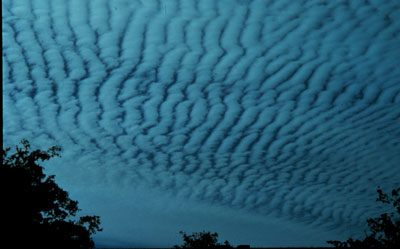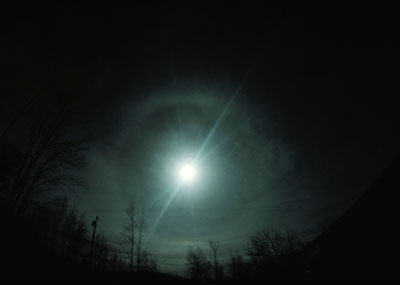
Mariner Weather Folklore
By Paula Hughes Court

For centuries, sailors relied on weather lore to foretell
tomorrow's weather. Their very lives depended on observing wind shifts, clouds
and even the moon for signs of weather change. While we've all heard the
familiar sayings such as, "pink at night, sailor's delight," most of us
dismissed these old proverbs as meaningless rhymes. The truth is-many of these
sayings have a valid scientific explanation behind them and they work.
Take a look at the following well-known weather proverbs and see if you can
guess the meaning before reading the scientific explanation that follows.
· Red sky at night, sailor's delight; red sky in the morning, sailor's warning.
A red or pink sky in the evening is actually light interacting with dry dust
particles, which indicates dry weather is coming. A gray evening sky means the
atmosphere is heavy with water droplets that will likely fall the next day.

· Mackerel sky, not three days dry. Clouds that look like mackerel or fish
scales, means rain within 24 hours. These clouds are high, thin ice crystal
clouds that show up well in advance of a storm system.
· Seagull, seagull, get off the sand, it's never good weather when you're on
land. During fair weather, seagulls scavenge at the waters edge or offshore.
During stormy weather, they fly inland.
· Rain before seven, fine before eleven. Air mass thunderstorms tend to break up
before the heat of the day. So, if it's raining before seven a.m., it will most
likely clear up before eleven.

· Rainbow in the eastern sky, tomorrow will be dry; rainbow in
the west that gleams, rain falls in streams. Rainbows occur when rain clouds are
opposite the sun. In the mornings, the sun is in the east, so a rainbow in the
west would mean a rain cloud is coming toward you. A rainbow in the east means
the rain is behind you and fair weather is ahead.
· If the new moon holds the old moon in her lap, expect fair weather. "Holding
the old moon in her lap" means if you look at the new moon and see the outline
of the remainder of the moon that is in shadow, expect fair weather. In fair
weather conditions the air is more stable, which allows us to see dim objects in
the sky.

· A ring around the sun or moon, means that rain will come real soon. The ring
around the moon is caused by refraction of light through ice crystals. The
presence of ice crystals often precedes a weather system and is a good sign rain
is on the way.
· When the goose flies high, fair weather; if the goose flies low, foul weather.
Birds adjust their flight to the level of highest barometric pressure. Before a
storm, barometric pressure falls and the optimum air density for flight is
closer to the ground.
· Fish bite best before a rain. When barometric pressure starts to fall, bubbles
formed by decaying products on the lake bottom start to expand, making parts of
the decaying matter buoyant enough to rise. Minnows start to feed on the rising
matter, and larger fish start feeding on the minnows.
· When the stars begin to huddle, the earth will soon puddle. When clouds
increase, they cover many of the sky's stars, leaving the remaining stars in
"huddles." With the clouds, comes an increasing chance of rain.